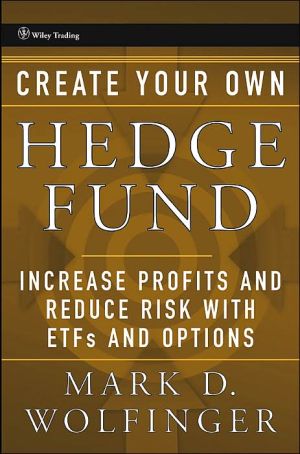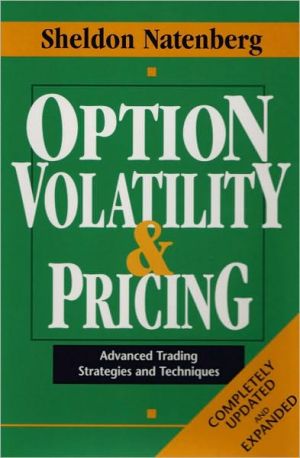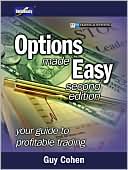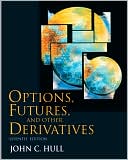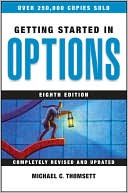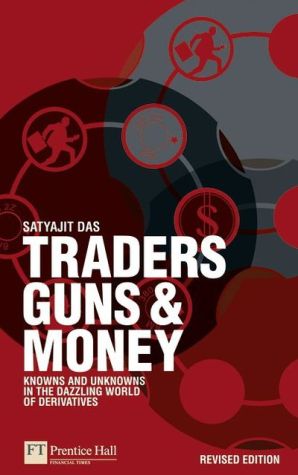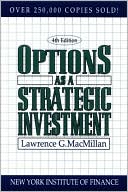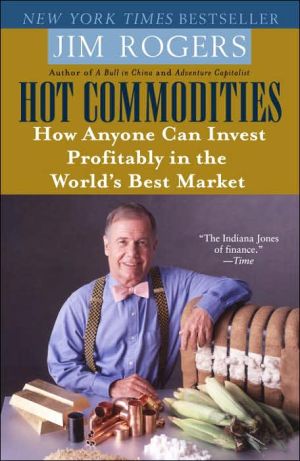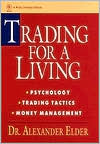Create Your Own Hedge Fund: Increase Profits and Reduce Risks with ETF's and Options (Wiley Trading Series)
"Options writing made simple for the layman."\ —James Altucher, author of Trade Like a Hedge Fund\ "One of the clearest explanations of how to use options as they were originally intended: as a component of an overall strategy in conjunction with other positions."\ —Robert V. Green, Investment Strategist, Briefing.com\ "Wolfinger combines the versatility of options and the benefits of diversified exchanged traded funds to present an amazing new form of low-risk, enhanced return investing....
Search in google:
Wolfinger explains how investors can increase profits and reduce risk through the combined use of exchange traded funds (ETFs) and options. Affordable for most investors, this approach is designed to work well in all kinds of markets and provide overall package returns that are steadier than those provided by its component pieces. Currently an educator of public investors, Wolfinger has worked in the options business since 1977. Annotation ©2004 Book News, Inc., Portland, OR
Create Your Own Hedge Fund\ \ By Mark Wolfinger \ John Wiley & Sons\ ISBN: 0-471-65507-4 \ \ \ Chapter One\ Modern Portfolio Theory \ People invest money in the stock market with one primary goal in mind: to earn a satisfactory return on that investment. Some consider investing to be a full-time occupation with the goal of earning enough to provide for their day-to-day living expenses on a continuing basis. Some will be retiring soon and must plan to begin using their investment nest egg to meet expenses. Others have a much longer time horizon and are planning 30 or 40 years into the future.\ With such a variety of time frames and purposes, there is no single investment strategy that suits all investors. There is no single "best" portfolio of investments to own.\ INDIVIDUAL INVESTORS\ Many individual investors decide for themselves which specific stocks to own. Whether the buying decision is based on sound research into the fundamentals, including a thorough reading of the various financial reports issued by the company, or whether price history charts are studied in an effort to perform a thorough technical analysis, or whether an investment decision is based on a tip received from a stockbroker, bartender, chat room, or a talking head on CNBC or Wall Street Week, investors seldom consider their entire portfolio when making a new purchase. The buying decision is often based on investors' belief (hope) that some information has been uncovered-information notyet known to other investors-that will soon make the price of the newly purchased stock soar.\ Some investors make investment decisions alone, shunning the advice of others. Some rely on the camaraderie of an investment club. Some listen to the advice of professionals before making the final decisions themselves. Some blindly follow the advice of a stock market advisory newsletter while others do everything their stockbrokers suggest. Regardless of the source of an investment idea, most individual investors never think twice about whether the new investment is suitable or whether it helps them achieve their overall investment goals. In fact, many have no overall objectives in mind and simply make new purchases to produce a portfolio based on chaos. Some investors are happy with their results, while others are not. Modern portfolio theory (MPT) teaches us that this is a poor way to invest. With so many investors accumulating stocks and building a portfolio in this haphazard manner, it's important to know: Are individual investors generally successful? The answer to this question is postponed until Chapter 2.\ Investing in Mutual Funds\ Many millions of other investors don't want to take the time or make the effort to choose their own stocks. Instead, they rely on financial professionals to make investment decisions for them. Some of these investors follow the advice of a guru who sells stock market advice for a fee (e.g., newsletters and advisory services), while others accept the investment advice of financial planners or stockbrokers. But the vast majority of these investors buy shares of mutual funds.\ Mutual funds serve a great purpose. They allow investors to quickly own a diversified portfolio of stocks without being required to buy shares in each of the individual companies. This is especially important for small investors who lack the funds to own a properly diversified portfolio of stocks. It has been known for a long time that proper diversification is a strategy that reduces the risk of investing in the stock market. It's one of the cornerstones of MPT.\ Having decided to buy shares of mutual funds, investors must rely on the ability of fund managers to make intelligent investment decisions and earn a good return on investor capital. Some investors make a careful study of mutual funds before selecting which to buy. They study how well mutual funds have performed in the past; they check out Morningstar's rating on the funds, or they accept the advice of a stockbroker. Some investors go further and choose funds that invest in the type of stocks they want to own. For example, some funds only buy stocks of large companies; others specialize by investing in smaller, growing companies. Some funds buy stocks for income (dividends); others buy stock for long-term growth. Some funds specialize in the companies in one specific industry (sector funds); others are more diversified. Some buy stocks in American companies; others invest in businesses from around the world. There are many mutual funds in existence, each with its own investment strategy, and the public investor can choose any of them.\ Some who buy shares of mutual funds invest their money, close their eyes, and, placing their trust in the fund's managers, hope for the best. Others take the opposite approach and constantly monitor the performance of their funds and hop from one fund to another, chasing those with the best recent performance.\ Most of those who invest in mutual funds would be better served if they had an understanding of how to construct a safer and better-performing investment portfolio on their own. Our goal is to show you, the individual investor, how to do just that.\ Some investors are sophisticated enough to know how to avoid paying a sales commission (load) when buying funds; others pay that load, not knowing there is any alternative. The bottom line for the vast majority of mutual fund investors is that once the decision to buy a fund is made, no further thought goes into the process. They leave it to the fund management team to produce superior returns on their money. Over the years, most investors have been satisfied with this methodology, especially since the trend of the American stock market has been bullish over the long term. With so many Americans relying on mutual funds to meet their investment objectives, two important questions must be considered: Are mutual fund investors generally successful? Are they well served by the managers of those funds? Let's postpone a discussion of the answer until Chapter 5.\ MODERN PORTFOLIO THEORY\ Investors seldom, if ever, consider their entire portfolio as anything but a collection of individual investments, regardless of whether those investments are individual stocks, mutual funds, or any of numerous other assets, such as bank certificates of deposit, bonds, or coin collections. Few consider whether adding a new investment to a portfolio affects the overall risk parameters of the portfolio, or whether it helps to diversify their holdings. Usually asset allocation is totally ignored. This is not a good thing.\ There exists a large body of knowledge that has collectively become known as modern portfolio theory. MPT tells us that investors can successfully (and easily) use a scientific approach to compile an investment portfolio. It's worthwhile to make a brief study of this collection of knowledge because it contains ideas you can easily adopt to make your own investing more efficient and more profitable. One of the great benefits of MPT is that it shows how to increase the expected profits and lower overall risk at the same time\ MPT is concerned with the methods used to compile an investment portfolio and with the performance of that portfolio. Investors can easily earn the risk-free rate of return by purchasing U.S. Treasury bills. But to earn more, investors must accept the fact that a certain amount of risk must be accepted. It's generally understood in the investment world that the greater the risk of an investment, the greater the potential reward. This must be true, or else no one would ever knowingly accept greater risk. It's important to point out that the term "risk" is usually considered to represent the chances of losing money from an investment. According to MPT, risk is much more than that; it's also a measure of how much the return on an investment varies from the expected return. Thus, risk is a measure of the uncertainly of the future.\ The work of Harry M. Markowitz changed the way investment managers think, when he demonstrated that including certain classes of assets in a portfolio influenced not only the profit potential of that portfolio, but also its volatility, or the rate at which the value of a portfolio fluctuates. The major conclusion of MPT that concerns our discussion is how to construct an investment portfolio that aims for higher profits with reduced risk.\ Markowitz did the original work in this field, and others have made significant contributions. Among those are Professors Sharpe, Cootner and Fama. A good discussion of MPT can be found in the text authored by Rudd and Clasing. The theory is not some obscure topic of interest only to academics, but is widely used in today's investment universe. Markowitz and Sharpe shared the Nobel Prize in economics in 1990 for their contributions to this field.\ The early development of MPT relied heavily on statistics, and the pioneering work is highly technical. Nevertheless, the basics of MPT can be explained in simple terms (the more complex math remains available for those readers interested in such details). The discussion here is limited to explaining what MPT is, why it's important for today's investor to understand its basic teachings, and how you can easily build a portfolio based on its precepts.\ Here is a simple summary of how MPT describes the thought process behind investing:\ An investment is made in a security, or portfolio of securities, in anticipation of receiving a monetary reward. The expected reward is the average reward that results from holding the specific investment(s). Some years the return on the investment exceeds the expected return, and some years the return on the investment is less. The investment universe is filled with uncertainties, and, therefore, there is a certain degree of risk encountered when attempting to collect the reward. The risk is a measure of the uncertainty of earning the expected return. Thus (states the theory), an investor chooses among investment possibilities based entirely on the two measures of risk and reward, attempting to minimize the former and maximize the latter.\ ASSET ALLOCATION AND ITS ROLE IN MODERN PORTFOLIO THEORY\ What does MPT tell an investor about how to choose the components of a portfolio? The first idea is to diversify one's holdings and to allocate part of the investment capital among several asset classes. Reasonably enough, this strategy is known as asset allocation. Not so many years ago, asset allocation meant owning a variety of stocks and bonds and some cash equivalents. The prudent man rule reinforced this type of thinking among fiduciaries, or those responsible for investing other people's money. Today MPT goes further and focuses on the portfolio as a whole, and not on its individual components. But proper diversification remains an essential ingredient of MPT.\ When following MPT to build a portfolio, it's not sufficient to compile a portfolio simply by investing in different asset classes (e.g., stocks, bonds, gold, and real estate). MPT teaches that it's important to find the optimal allocation of assets satisfying both the investor's risk tolerance and reward (expected rate of return). It's important to own a variety of investments that perform differently in the marketplace. In other words, there should be minimal correlation in the performance of each individual investment with each of the other investments. If it sounds difficult to build a portfolio one stock at a time that satisfies these parameters, especially for an individual public investor, be assured that it is indeed difficult. But don't fret, as there is an easy method to accomplish this goal for the portion of your investment capital that you allocate to the stock market. That method is the basis of this book. A well-qualified financial advisor ought to be able to help you achieve the type of portfolio recommended by MPT for any assets you own that are not stock market related.\ Again, it's important to reiterate that our discussion focuses on only that portion of your assets you have allocated to investing in the stock markets of the world. This book makes no recommendation on how you should otherwise allocate your assets. MPT tells us that asset allocation should not be ignored, as it represents the best method of reducing the overall risk of your portfolio. Numerous books offer advice on how to allocate assets in accordance with MPT, and we'll leave that discussion to them.\ THE PRUDENT INVESTOR\ The prudent man rule contains guidelines for those responsible for investing other people's money. The purpose of the rule is to offer protection to investors by providing those fiduciaries with investment guidelines. Over the years, the rule has changed with the times. At one point, it would have been considered lunacy to invest the savings of a public investor in the stock market. After World War II, as inflation became important in making financial decisions, it was considered extremely imprudent for a fiduciary not to invest in the market. Today it is not enough to merely invest in stocks, and the prudent man rule requires that fiduciaries invest at least part of an investor's funds via passive investing, using index funds. Passive investing is consistent with the teachings of MPT and represents an important part of our overall recommended investment strategy. It's the basis of further discussion in Chapter 2.\ At one time, a fiduciary had the difficult responsibility of being certain that each investment was appropriate for an investor. Today, taking MPT into consideration, the prudent investor rule has been revised to "focus on the portfolio as a whole and the investment strategy on which it is based, rather than viewing a specific investment in isolation." As a result, it's acceptable for fiduciaries to recommend shares that would be risky as standalone investments, as long as the entire portfolio is appropriate for the investor.\ DIVERSIFICATION\ Diversification is an essential element when following MPT. The easiest way for public investors to diversify has been to own shares of traditional mutual funds. Their very existence is one reason why so many Americans are currently stock market investors, as mutual funds make it easy for public investors to own a professionally managed diversified portfolio of stocks. The wisdom of relying on these professional money managers is one of the subjects covered in MPT and this discussion is continued in Chapter 2.\ Chapter Two\ Can You Beat the Market? Should You Try? \ The academics say, "No way." Professional money managers say, "We do it all the time." What's this argument about? It's a debate over whether anyone can build a portfolio of stocks that outperforms the market on a consistent basis. Academics claim the market's ups and downs are random and that it's not possible either to time the market or predict which stocks are going to outperform the market in the future. Money managers claim the ability to do research and determine which stocks are undervalued and beat the market by buying those stocks. This is an ongoing disagreement with no end in sight.\ Those who believe it's not possible to beat the market make this argument:\ Gross returns earned by investors as a group must equal the gross returns earned by the total stock market. Net returns-after advisory fees and other investment expenses-earned by investors as a group must fall short of the returns of the market by the amount of those costs.\ Those making this argument believe that simply hiring professional managers and paying fees for their services is enough to guarantee below-average returns over the long term. Their suggestion is to invest in index funds because those funds do not spend money on research and save money on commissions by owning and holding an investment portfolio. These funds charge much lower fees than traditional mutual funds, and those reduced fees enable index funds to come very close to matching the performance of the market (as measured by the index they are trying to mimic). This investment methodology is discussed further later in this chapter.\ Those who believe in the efficient market theory believe that markets must be inefficient (information becomes available to different participants at different times) in order for any individuals to demonstrate the skills required to compile a portfolio of stocks that consistently generates above-average profits. But, since they believe the market is efficient and all information that can possibly be known is already known, and that such information is already priced into the price of every stock, they believe no one has any special advantage and therefore no one can consistently outperform the market. Statistically there are always some who do outperform and others who underperform, but there is no way for an investor to know in advance who can generate above-average returns. Thus, efficient market theorists conclude, spending money in an attempt to outperform the market is a foolish endeavor.\ (Continues...)\ \ \ \ \ Excerpted from Create Your Own Hedge Fund by Mark Wolfinger Excerpted by permission.\ All rights reserved. No part of this excerpt may be reproduced or reprinted without permission in writing from the publisher.\ Excerpts are provided by Dial-A-Book Inc. solely for the personal use of visitors to this web site. \ \
Ch. 1Modern portfolio theory3Ch. 2Can you beat the market? Should you try?9Ch. 3Hedge funds20Ch. 4A brief history of mutual funds and exchange traded funds29Ch. 5Traditional mutual funds32Ch. 6Exchange traded funds38Ch. 7What is an option and how does an option work?55Ch. 8More options basics60Ch. 9Why investors buy and sell options69Ch. 10Option strategies you can use to make money : covered call writing80Ch. 11Option strategies you can use to make money : uncovered put writing100Ch. 12Historical data : BuyWrite index and volatility index111Ch. 13Building a portfolio123Ch. 14Finding your style : choosing an option to write131Ch. 15Covered call writing in action : a year of trading141Ch. 16Uncovered put writing in action195Ch. 17Odds and ends and conclusion212
